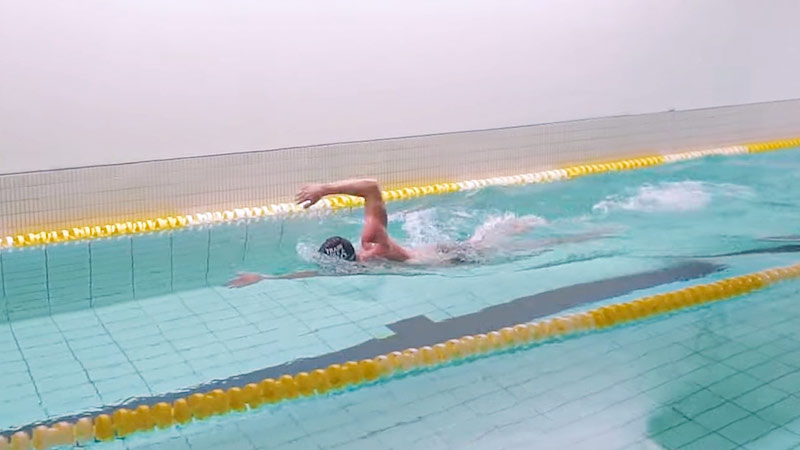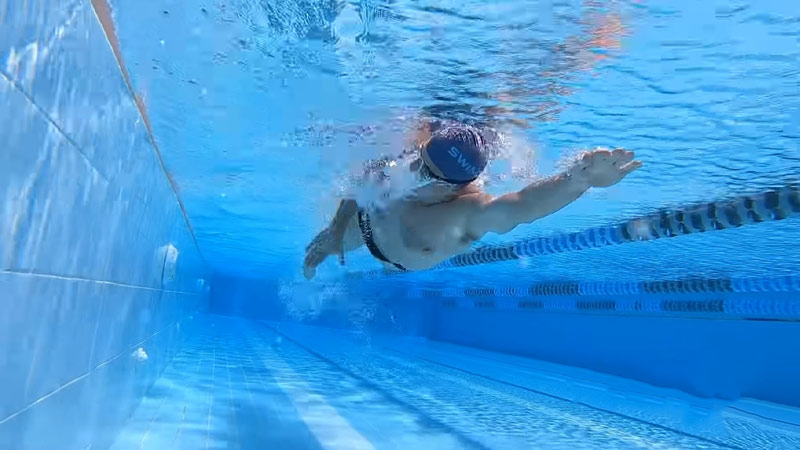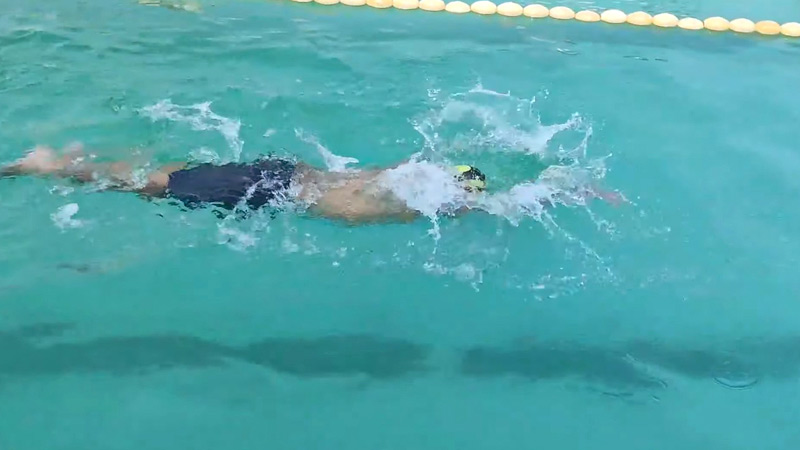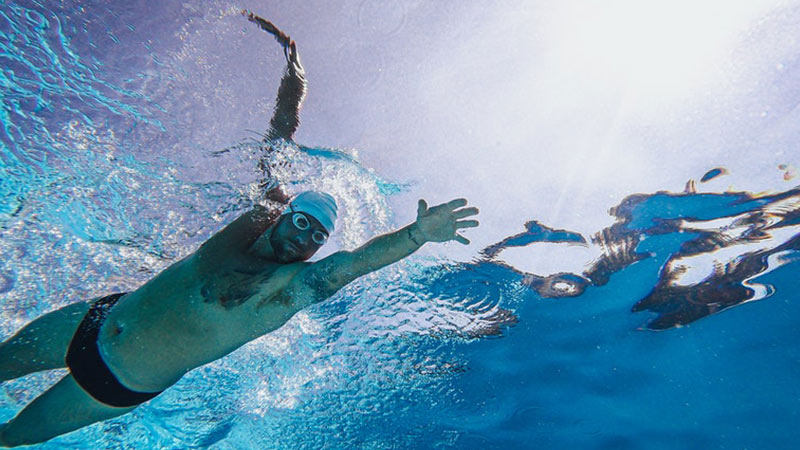Swimming is an art that combines grace, power, and efficiency. A fundamental element of this art lies in the technique of kicking from your hips.
Whether you’re a novice swimmer looking to refine your form or an experienced athlete aiming to boost your speed and endurance, mastering hip-driven kicking is essential.
In this comprehensive guide, we’ll dive deep into the world of swimming kicks and explore the techniques required to propel yourself through the water with grace and strength.
Kicking from your hips is the key to minimizing resistance, optimizing propulsion, and maintaining a streamlined body position. It’s the secret to smoother freestyle, backstroke, butterfly, and breaststroke strokes.
Join us as we uncover the essential skills, drills, and tips to enhance your swimming experience. From the basics of hip flexibility to perfecting the synchronized rhythm of your kicks, we’ve got you covered.
Get ready to unlock your full aquatic potential and become a more efficient and powerful swimmer.
How to Kick from Your Hips in Swimming?
Kicking from your hips is an important technique in swimming, particularly in freestyle, backstroke, and butterfly strokes.
It helps you maintain an efficient and streamlined body position in the water, allowing you to propel yourself forward with minimal drag.
Here’s how to kick from your hips in swimming:
Body Position
Start by maintaining a horizontal body position in the water. Keep your body as straight and streamlined as possible. Your head should be in line with your spine, and your hips should be close to the surface.
Hips and Legs Alignment
Keep your hips close to the water’s surface. To do this, your hips should be in line with the rest of your body, and your legs should follow the same line. Avoid dropping your hips or letting them sink, as this will create additional drag.
Kick from the Hips
Instead of bending your knees excessively or using your knees to initiate the kick, focus on kicking from your hips.
Your legs should move from your hips in a fluid, undulating motion. Imagine your legs are like a single unit, and they are moving up and down together, rather than separately.
Kick Rhythm
The kick rhythm should be continuous and alternating, meaning one leg kicks as the other one recovers. The timing depends on the stroke you’re swimming:
In freestyle and backstroke, the kick should be a flutter kick, where your legs alternate kicking, with a slight bend at the knees. The motion is primarily generated from the hips.
In butterfly, the kick is a simultaneous, dolphin kick, where both legs move up and down together, again driven by the hips. The kick in butterfly is more powerful and rhythmic than in freestyle or backstroke.
Ankle Flexibility
While you’re kicking from the hips, maintain some flexibility in your ankles.
Your feet should be relatively relaxed with pointed toes in freestyle and backstroke and slightly pointed toes in butterfly. This allows for a more efficient kick and less resistance in the water.
Practice and Feedback
Kicking from your hips effectively takes practice. You can use a kickboard or practice drills specifically focused on your kicking technique.
Consider getting feedback from a coach or experienced swimmer to help you improve your hip-driven kick.
Core Strength
Building core strength is essential for maintaining a strong and stable hip position in the water. A strong core will help you control your body position and movement.
Remember that mastering the technique of kicking from your hips may take time and practice.
Focus on staying streamlined and reducing drag while generating propulsion through your hip-driven kick. This technique will help you become a more efficient and faster swimmer.
The Basics of Swimming Kicks

Swimming kicks are an integral part of various swim strokes, including freestyle, backstroke, breaststroke, and butterfly. Here are the basics of swimming kicks for each of these strokes:
Freestyle Kick
- Kick Type: Freestyle, or front crawl, typically employs a flutter kick.
- Flutter Kick Technique: The flutter kick is a continuous, alternating motion where one leg kicks down as the other leg comes up. It’s essential to keep your legs relatively straight but not rigid, with a slight bend at the knees. The kick originates from the hips, and the motion is primarily up and down.
- Ankle Flexibility: Maintain some ankle flexibility, pointing your toes and creating minimal resistance with your feet.
- Rhythm: The kick rhythm should be steady and coordinated with your arm strokes in freestyle.
Backstroke Kick
- Kick Type: Backstroke utilizes a flutter kick, similar to the freestyle kick.
- Flutter Kick Technique: The same flutter kick technique applies in backstroke. Keep your legs straight with a slight knee bend, and alternate your kicks in a continuous and rhythmic manner.
- Ankle Flexibility: As in freestyle, maintain ankle flexibility with pointed toes.
- Rhythm: Coordinate the kick with your arm movements in backstroke to maintain balance and propulsion.
Breaststroke Kick
- Kick Type: Breaststroke employs a unique whip kick, also known as a frog kick.
- Whip Kick Technique: In the whip kick, your legs move simultaneously outwards and then inwards. Start with your legs together, bend your knees, and bring your heels toward your buttocks. Then, simultaneously kick your legs outward and then bring them back together, similar to a frog’s kick.
- Timing: The whip kick is performed as you complete your arm pull in breaststroke. It is a powerful part of the stroke, providing propulsion.
- Glide: After the whip kick, stretch your legs and glide briefly before initiating the next arm pull and kick.
Butterfly Kick
- Kick Type: Butterfly uses a simultaneous dolphin kick.
- Dolphin Kick Technique: In the dolphin kick, your legs move up and down together in a fluid wave-like motion. The motion starts from the hips and is driven by the core and abdominal muscles.
- Ankle Flexibility: Keep your feet close together with pointed toes, and maintain ankle flexibility.
- Rhythm: The dolphin kick is fast and rhythmic, with a powerful upward kick and a streamlined downward recovery. It is a fundamental part of the butterfly stroke.
Remember to practice and develop the appropriate kick for each stroke to ensure maximum efficiency and speed in the water.
Proper body position, timing, and technique are crucial in all these kicks to maintain a streamlined position and minimize resistance while generating propulsion.
Benefits of Kicking from the Hip Swimming

Kicking from the hips in swimming offers several benefits, regardless of the stroke you are using.
This technique is essential for maintaining an efficient and streamlined body position in the water, and it provides various advantages:
Reduced Drag
Kicking from the hips helps to keep your body in a horizontal and streamlined position. This reduces water resistance and drag, allowing you to move through the water with less effort.
Improved Efficiency
When you kick from the hips, you generate propulsion more efficiently.
The hip-driven kick focuses on moving the legs in a way that complements your arm movements, promoting a smoother and more coordinated swimming technique.
Increased Speed
A more efficient kick allows you to swim faster for the same level of effort. As your legs contribute to your forward movement with less resistance, you can cover more distance in less time.
Stability and Balance
Kicking from the hips helps you maintain better stability and balance in the water. This is crucial for strokes like freestyle and backstroke, where body position plays a significant role in your performance.
Core Strength
Kicking from the hips requires engagement of the core muscles. Over time, this will help strengthen your core, improving your overall swimming posture and technique.
Conservation of Energy
An efficient hip-driven kick allows you to conserve energy during your swim. With less energy wasted on overcoming resistance, you can swim longer distances without tiring as quickly.
Better Timing
Proper hip-driven kicking complements the timing of your arm strokes in various swimming strokes, such as freestyle and backstroke. This synchronization enhances your overall stroke rhythm.
Reduced Risk of Injury
Kicking from the hips, as opposed to using excessive knee bending, can reduce the risk of knee injuries in swimming. The kick is gentler on your joints and less likely to cause strain or discomfort.
Greater Speed and Power in Butterfly
For the butterfly stroke, the dolphin kick powered by the hips and core generates significant speed and power. This is crucial for maintaining the demanding rhythm of the stroke.
Better Underwater Phases
In strokes like freestyle and backstroke, an effective kick from the hips is beneficial during the underwater phases, such as starts and turns.
It allows you to maintain propulsion and momentum when not using your arms.
Kicking from the hips in swimming is a fundamental technique that enhances your swimming performance by reducing drag, improving efficiency, and promoting better overall body control in the water.
Whether you’re a competitive swimmer or a recreational one, mastering this technique can help you become a more skilled and efficient swimmer.
Common Mistakes in Swimming Kicking Technique

Swimming kicking technique is crucial for propulsion and maintaining a streamlined position in the water. Several common mistakes can hinder your kicking efficiency and overall swimming performance.
Here are some of the most frequent errors in swimming kicking technique:
Kicking from the Knees
One of the most common mistakes is kicking primarily from the knees, resulting in a bicycle-like motion. This generates excessive drag and reduces propulsion. To correct this, focus on initiating the kick from your hips.
Splaying Legs
Allowing your legs to splay outwards during the kick creates extra resistance and disrupts your body’s streamlined position. Keep your legs close together, especially during the recovery phase.
Inadequate Ankle Flexibility
Pointed toes and ankle flexibility are important in most swimming kicks. Failing to maintain this flexibility can lead to extra resistance, slowing you down.
Practice ankle flexibility exercises to improve this aspect of your kick.
Kicking Too Wide
In freestyle and backstroke, a wide or excessive kick can waste energy and create resistance. Keep your kicks within the line of your body to maintain an efficient, streamlined position.
Lack of Coordination
Proper coordination between your arms and legs is essential for efficient swimming. Avoid kicking too fast or too slow relative to your arm strokes. Aim for a balanced rhythm to maintain stability and propulsion.
Inconsistent Kick Intensity
Keeping a consistent and rhythmic kick throughout your swim is important. Some swimmers may kick too hard at the beginning of a lap, exhausting themselves, and then lose propulsion during the rest of the lap.
Insufficient Hip Engagement
In many strokes, the hips are the primary source of power for the kick. Failing to engage the hips properly can lead to a weaker and less efficient kick. Focus on using your core muscles to generate power from the hips.
To improve your swimming kicking technique, consider working with a coach or experienced swimmer who can provide feedback and drills to address these common mistakes.
Regular practice and attention to these details will help you become a more efficient and effective swimmer.
Techniques to Kick from Your Hips

Kicking from your hips is a fundamental technique in swimming to maintain a streamlined body position and maximize propulsion.
Here are some techniques and tips to help you kick from your hips effectively in various swimming strokes:
Body Position
Maintain a horizontal body position in the water. Keep your head in line with your spine and your hips close to the water’s surface. This minimizes resistance and allows for better hip engagement.
Hip Flexibility
Ensure that your hips are flexible and mobile. Stiff hips can hinder your ability to kick effectively from this area. Stretching exercises can help improve hip flexibility.
Core Engagement
Engage your core muscles, including your abdominals and lower back, to help initiate and control the movement from your hips. A strong core is essential for hip-driven kicks.
Hip Rotation
In freestyle and backstroke, practice rotating your hips with each kick. The rotation aids in generating power and balance in your stroke.
Leg Position
Keep your legs relatively straight, with a slight bend at the knees, while kicking. Avoid excessive knee bending, which can lead to a less efficient kick.
Continuous Motion
Make the kicking motion continuous and rhythmic. In freestyle and backstroke, maintain an alternating flutter kick, and in butterfly, perform a continuous dolphin kick.
Upward Kick (Butterfly)
In butterfly, focus on a strong and powerful upward kick that originates from the hips. This upward movement creates most of the propulsion in the stroke.
Downward Recovery (Butterfly)
After the upward kick in butterfly, keep your legs close together and streamline them downward before beginning the next kick. This minimizes resistance.
Ankle Flexibility
Maintain flexibility in your ankles, and point your toes during the kick. This helps reduce resistance and creates a more streamlined position.
Coordination with Arms
Coordinate your hip-driven kick with your arm strokes in freestyle and backstroke. The timing of your kick and arm pull should complement each other.
Visualization
Visualize a fluid, undulating motion coming from your hips when you kick. Imagine your legs as an extension of your core, moving as a single unit.
Remember that mastering the art of kicking from your hips takes time and effort. Be patient with yourself and focus on making gradual improvements in your technique.
As you refine your hip-driven kicking technique, you’ll become a more efficient and faster swimmer.
FAQs
How to kick from your hips in swimming?
To kick from your hips in swimming, keep your legs relatively straight and initiate the movement from your hips, not your knees. Maintain a flexible ankle for a flutter kick, and practice a scissor kick for breaststroke.
How to kick from hips swimming?
Kicking from your hips while swimming involves engaging your core and leg muscles to generate a strong kick. Keep your legs extended with a slight bend at the knees and initiate the movement from your hips.
How to kick from the hips in swimming?
Kicking from the hips in swimming requires maintaining a streamlined body position and generating propulsion from your hip muscles. Ensure your legs are stretched, and the power for the kick comes from the hips.
How to kick when swimming?
When swimming, use flutter or scissor kicks to propel yourself. For a strong kick, initiate the movement from your hips, maintain a fluid ankle motion, and practice the appropriate kick technique for your chosen stroke.
Wrapping Up
Mastering the technique of kicking from your hips in swimming is a journey that promises improved efficiency, speed, and overall performance in the water.
This foundational skill isn’t reserved for elite swimmers; it’s accessible to anyone willing to put in the time and effort to refine their form.
From the graceful flutter kick of freestyle to the powerful dolphin kick of butterfly, the ability to initiate and control movement from the hips is indispensable.
It reduces drag, optimizes propulsion, and enhances stability, making your swimming experience smoother and more enjoyable.
Remember, practice and persistence are your allies on this journey. As you continue to develop your hip-driven kick, you’ll find yourself gliding through the water with greater ease and confidence.
So, dive in, embrace the art of swimming, and kick from your hips to become the best swimmer you can be. The pool is your canvas, and your strokes are your masterpiece.







